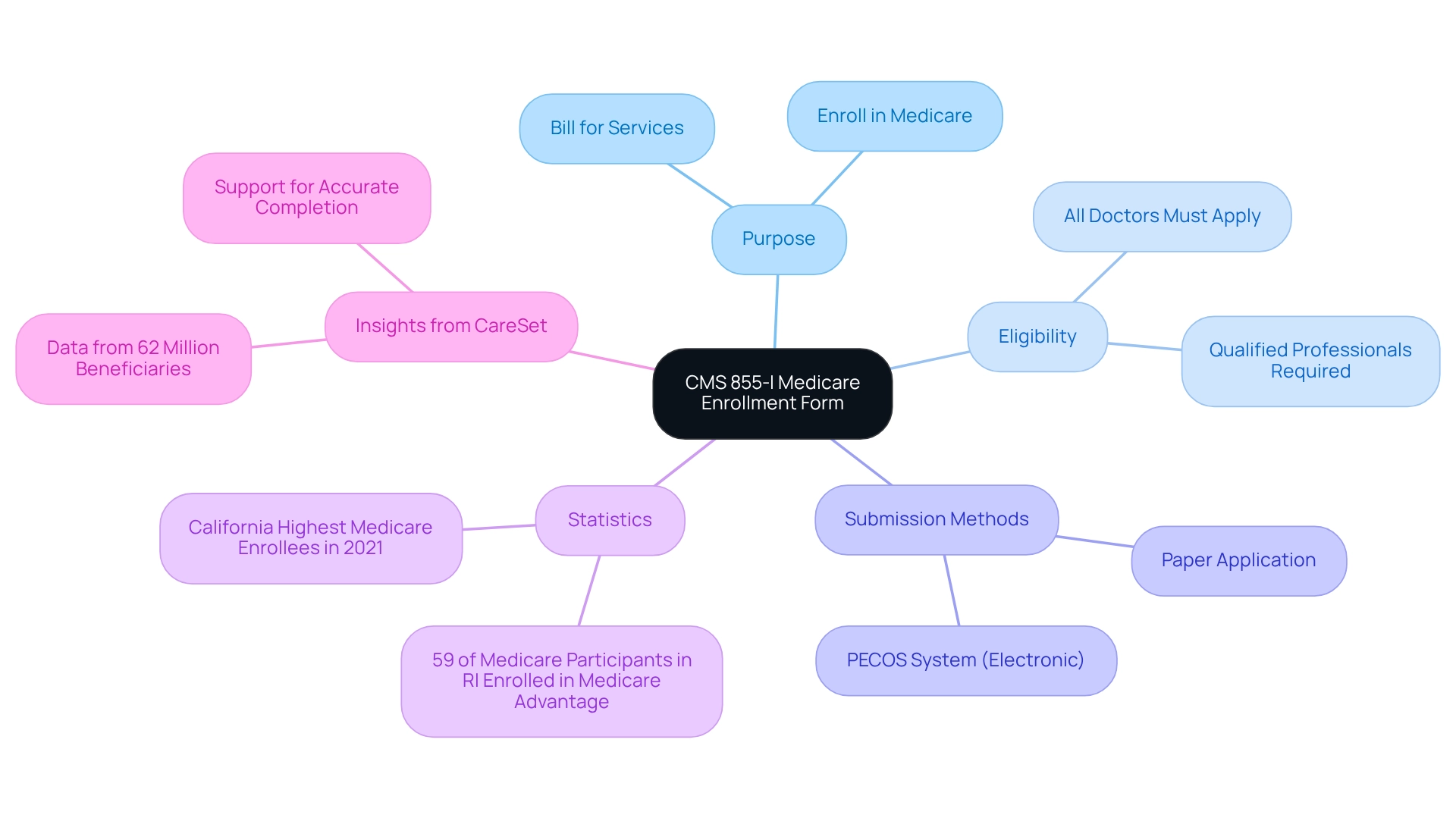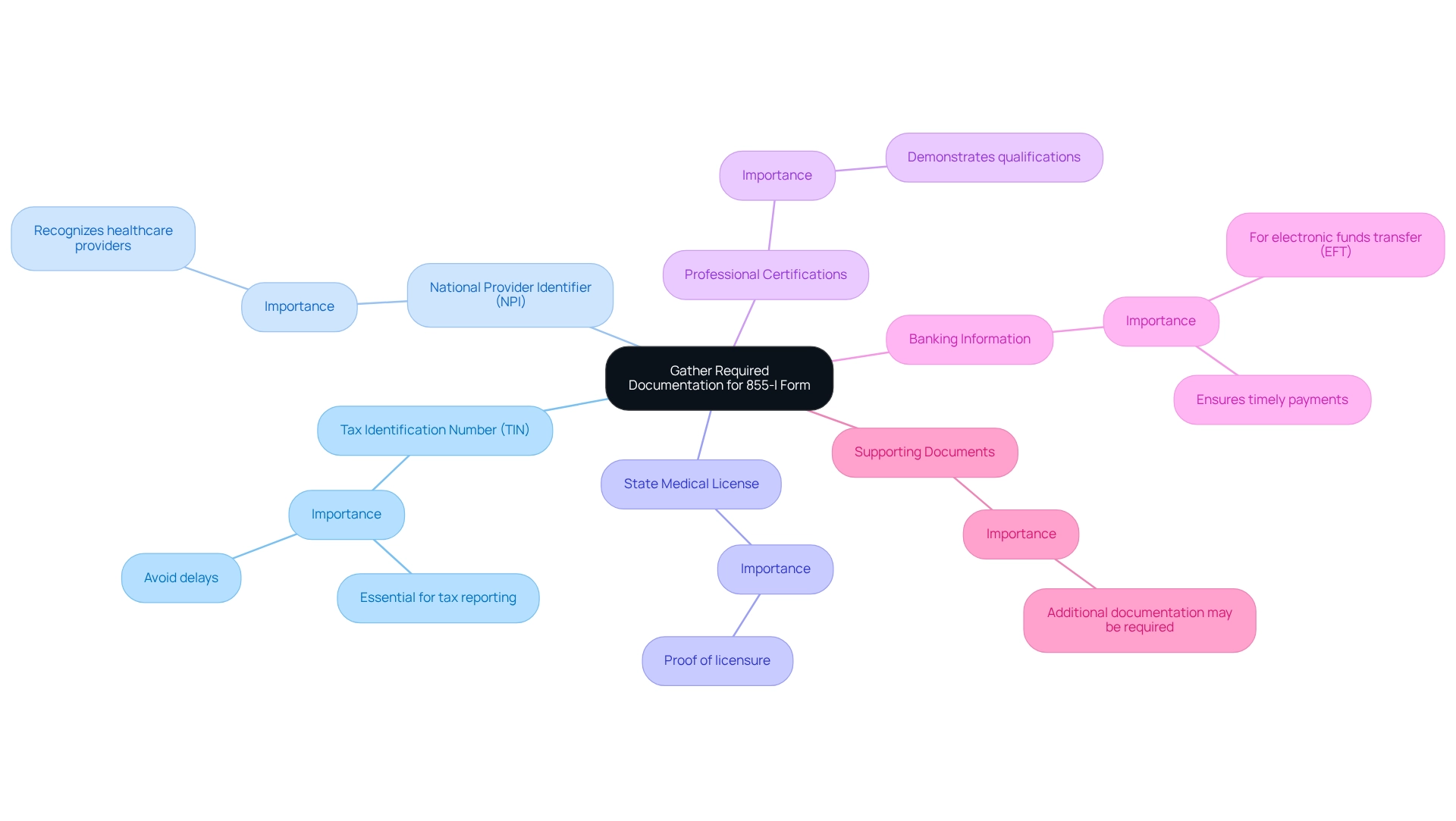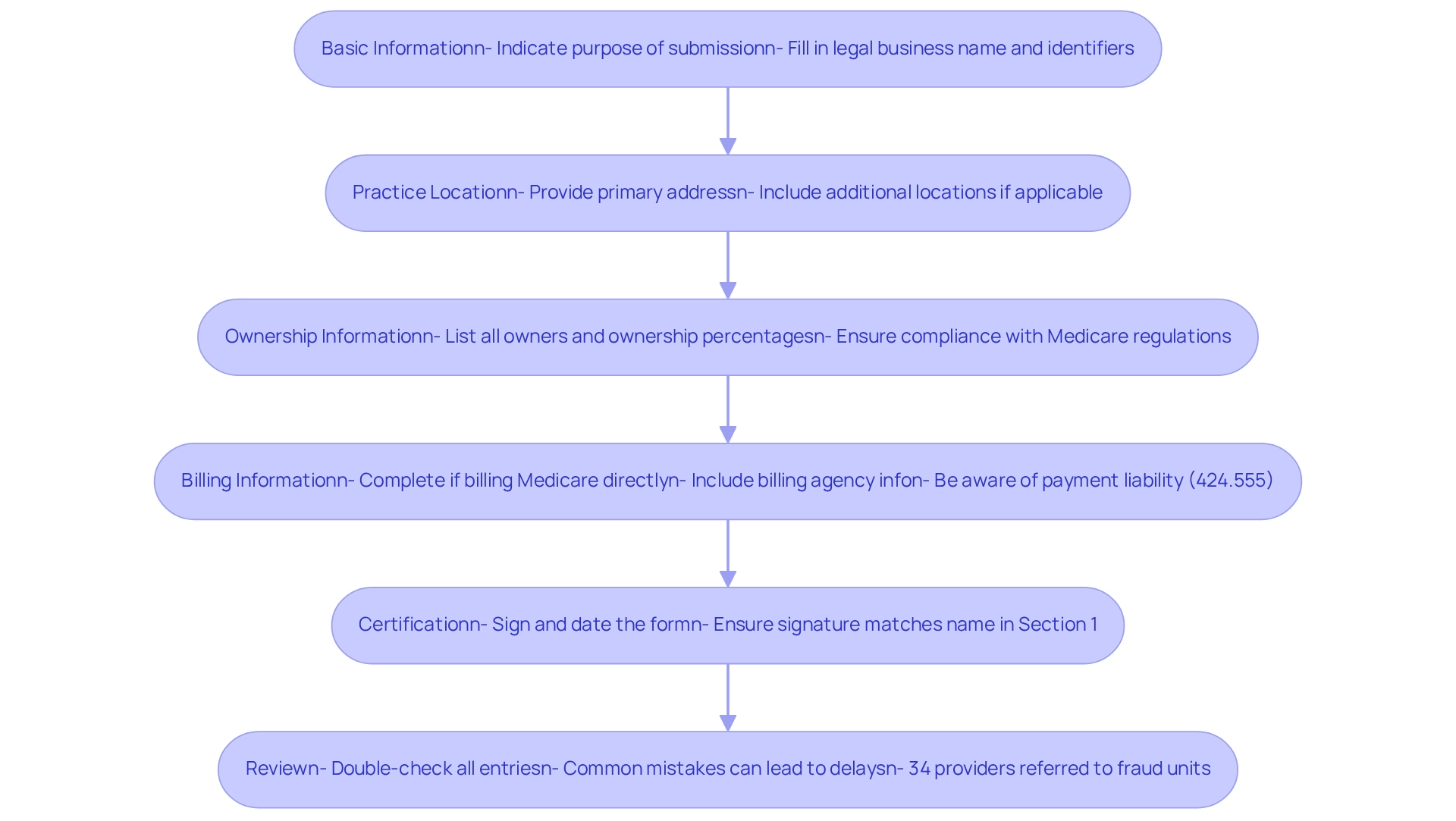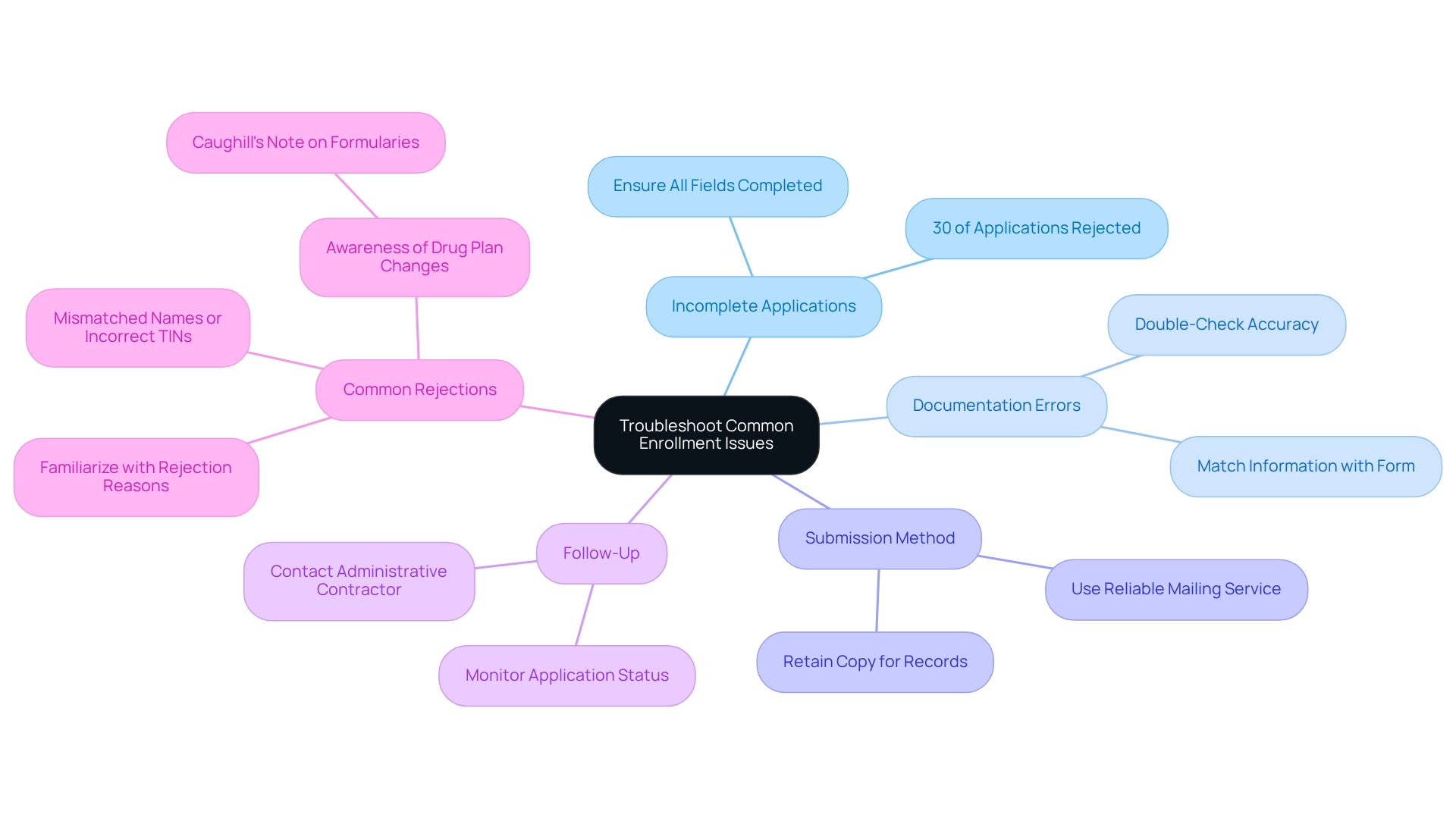Overview
The article offers a comprehensive step-by-step guide for completing the CMS 855-I form, a crucial requirement for physicians and non-physician practitioners seeking to enroll in the Medicare program. It underscores the critical importance of accurate documentation and meticulous completion of each section to prevent delays and ensure successful registration. Supported by statistics and expert insights, the article highlights common pitfalls and effective troubleshooting strategies, fostering a deeper understanding of the enrollment process.
Introduction
In the intricate realm of healthcare, the significance of accurately completing the CMS 855-I Medicare Enrollment Form is paramount. This essential document acts as the gateway for physicians and non-physician practitioners aiming to enroll in Medicare Part B services, a vital step in delivering care to millions of beneficiaries. Yet, the enrollment process presents numerous challenges that can result in substantial delays in patient care and billing.
Understanding the specific requirements of the form, gathering the necessary documentation, and troubleshooting common issues are all crucial elements that contribute to a seamless enrollment experience. By leveraging insights and strategies from CareSet, healthcare providers can confidently navigate this complex process, ultimately enhancing their capacity to provide quality patient care.
Understand the 855-I Medicare Enrollment Form
The CMS 855-I document functions as the enrollment application designed for physicians and non-physician practitioners, playing a crucial role in registering providers for Part B services. Precise completion of this document is vital to prevent processing delays and ensure that healthcare stakeholders can leverage CareSet’s extensive healthcare data insights for enhanced patient care and business success. Key components of the form include:
- Purpose: This form enables providers to enroll in the Medicare program, facilitating their ability to bill for services rendered to Medicare beneficiaries.
- Eligibility: All doctors and qualified professionals are required to submit the 855-I application to participate in Medicare.
- Submission Methods: Providers can submit the document electronically via the PECOS system or as a paper application.
Understanding the layout and requirements of the 855-I document is essential for successful registration. Recent statistics indicate that 59% of Medicare participants in Rhode Island are enrolled in a Medicare Advantage plan, underscoring the importance of accurate registration methods. Furthermore, healthcare experts have noted that ‘the difficulties of completing the 855-I can lead to significant delays in patient care,’ highlighting the critical nature of accuracy in this endeavor. By utilizing CareSet’s insights from over 62 million beneficiaries and 6 million providers, stakeholders can navigate the enrollment process more effectively. CareSet offers tailored solutions to assist providers in accurately and efficiently completing the 855-I application. Case studies reveal that California recorded the highest number of Medicare enrollees in 2021, illustrating the form’s role in facilitating access to Medicare services. Familiarizing oneself with these elements is the first step toward ensuring a seamless enrollment experience. For further details on how CareSet can support your registration efforts, contact us today!

Gather Required Documentation for Completion
To successfully finalize the 855-I form, it is crucial to gather the following documentation:
- Tax Identification Number (TIN): This is essential for tax reporting purposes related to the 855-I form and must be accurate to avoid delays.
- National Provider Identifier (NPI): This unique identifier is vital for recognizing healthcare providers within the healthcare system.
- State Medical License: Proof of your licensure to practice in your respective state is mandatory.
- Professional Certifications: Include any relevant certifications that demonstrate your qualifications and expertise in your field.
- Banking Information: For setting up electronic funds transfer (EFT), provide your bank account details to ensure timely payments.
- Supporting Documents: Depending on your specific practice type or circumstances, additional documentation may be required.
Having these documents organized and readily available will not only streamline the completion process but also significantly reduce the likelihood of common errors that can hinder registration. Statistics indicate that documentation errors are a leading cause of application delays, making thorough preparation essential. For instance, healthcare providers have reported that the average time taken to gather the necessary documentation can range from several days to weeks, depending on the complexity of their practice. Furthermore, the expense to substitute a Permanent Resident Card varies from $415 to $465, highlighting the financial consequences of maintaining precise records for healthcare registration.
Case studies emphasize the significance of efficient documentation management; one prominent example involved a large group of providers who coordinated their revalidation processes, resulting in a smoother experience and adherence to billing requirements. This underscores the importance of being proactive in collecting the appropriate documents, as noted by healthcare administrators who emphasize that having thorough and precise documentation is essential for successful registration in the program, particularly when dealing with 855-I. For further assistance, the CMS Provider Enrollment Assistance Guide can help users identify the correct contact for specific issues related to Medicare enrollment. As Faye Stewart, a writer and editor, notes, it is essential to make complicated topics more digestible, ensuring that all people are represented fairly in the documentation process.

Complete the 855-I Form Step-by-Step
To successfully complete the 855-i form, follow these detailed steps:
-
Section 1: Basic Information
- Clearly indicate the purpose of your submission, whether it is for initial enrollment or a change of information.
- Accurately fill in your legal business name along with any required identifiers to ensure proper processing.
-
Section 2: Practice Location
- Provide the primary address where services will be rendered.
- If applicable, include additional practice locations to prevent discrepancies.
-
Section 3: Ownership Information
- List all owners of the practice along with their respective ownership percentages.
- Identifying all owners is crucial to prevent processing delays and ensure compliance with Medicare regulations.
-
Section 4: Billing Information
- Complete this section if you intend to bill Medicare directly.
- Include information about your billing agency, if relevant, to streamline the billing process.
- Be aware of payment liability related to Medicare billing as outlined in section 424.555, which underscores the importance of accuracy in billing.
-
Section 5: Certification
- Sign and date the form, certifying that all information provided is accurate and complete.
- Ensure that the signature matches the name provided in Section 1 to avoid issues during verification.
-
Review:
- Thoroughly double-check all entries for accuracy and completeness before submission.
- Common mistakes include omitting required information or providing incorrect identifiers, which can lead to processing delays. Notably, 34 providers were directed to contractor fraud units during site visits, highlighting the significance of thoroughness.
Additionally, be aware that CMS will send revalidation notices to skilled nursing facilities (SNFs) from October to December 2024, which may impact your submission process. To stay informed about health care program modifications, consider subscribing to CMS alerts on the Federal Register site.
By meticulously completing each section and following these guidelines, you can significantly enhance the likelihood of a seamless application experience. Accurate fulfillment not only supports your registration but also improves patient outcomes, as evidenced by case studies that demonstrate the impact of data leadership in healthcare.

Troubleshoot Common Enrollment Issues
When navigating the health insurance enrollment process, addressing potential issues proactively can significantly improve your chances of success. Consider the following essential troubleshooting tips:
- Incomplete Applications: It is crucial to ensure that all required fields are thoroughly completed. Incomplete information remains a leading cause of application rejections, with studies indicating that approximately 30% of applications face issues due to missing details.
- Documentation Errors: Double-checking that all supporting documents are accurate and correspond precisely with the information provided on the form is imperative. Discrepancies can lead to delays or denials.
- Submission Method: If you are submitting your application by mail, utilize a reliable service and retain a copy of the application for your records. This guarantees you have proof of submission in case of disputes.
- Follow-Up: After submitting your application, it is essential to monitor its status through the PECOS system or contact your Administrative Contractor (MAC) for updates. Timely follow-ups can help identify and resolve issues quickly.
- Common Rejections: Familiarizing yourself with prevalent reasons for application rejections, such as mismatched names or incorrect Tax Identification Numbers (TINs), is beneficial. Understanding these pitfalls can help you avoid them. As Caughill notes, “It’s also important to note that drug plans can change their formularies, or the list of medications they cover, each year, meaning a drug covered this year might not be covered next year.” This underscores the necessity for attentiveness in the registration procedure.
By implementing these strategies and understanding the historical context of the Medicare enrollment process, which has evolved to include stricter requirements to combat fraud, you can navigate the enrollment process more effectively and enhance your likelihood of a successful application.

Conclusion
The successful completion of the CMS 855-I Medicare Enrollment Form is essential for healthcare providers seeking to enroll in Medicare Part B services. Understanding the form’s purpose, eligibility requirements, and submission methods lays the groundwork for a smooth enrollment process. Gathering the necessary documentation, such as:
- Tax Identification Numbers
- National Provider Identifiers
- State medical licenses
is crucial to avoid common errors that can hinder timely processing.
Following a step-by-step approach to fill out the form ensures accuracy, which is vital to prevent delays in patient care and billing. Addressing potential issues proactively, such as incomplete applications or documentation errors, can further streamline the enrollment process. By leveraging the comprehensive insights and support offered by CareSet, healthcare providers can navigate these complexities with confidence.
In conclusion, mastering the intricacies of the 855-I form not only facilitates smoother enrollment but also enhances the overall quality of patient care. The commitment to accurate and timely enrollment processes ultimately benefits both healthcare providers and the Medicare beneficiaries they serve. Taking the necessary steps to understand, prepare, and execute the enrollment process is an investment in the future of healthcare delivery.


